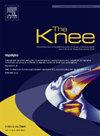前瞻性、随机研究比较了在两个单独的患者队列中使用自体半腱肌移植或Jewel合成独立装置重建ACL的临床结果
IF 2
4区 医学
Q3 ORTHOPEDICS
引用次数: 0
摘要
这项前瞻性研究旨在比较使用JewelACL人工韧带或自体半腱肌(ST)重建ACL的临床结果,随访时间至少为2年。患者和方法本研究招募了50名运动活跃的前内侧束损伤患者进行初级独立ACL重建。I组(20例患者,BMI为24.36±2.32,平均年龄40.65±11.43)采用Jewel ACL合成移植物,II组(30例患者,BMI为24.82±3.25,平均年龄35.57±7.18)采用ST自体移植物,两者均采用相同的手术技术。术前和术后评估包括ROM、Lachman、Pivot Shift、KT 1000、IKDC 2000、Cincinnati、Lysholm、Tegner评分和恢复运动时间。结果JewelACL组与ST组在ROM及评分上无统计学差异。与ST组的5.2个月和10.87个月相比,JewelACL组在2.6个月和4.65个月时更早地恢复参与运动。在手术当天,25%的JewelACL组和37%的ST组的Pivot Shift试验呈阳性。在24个月时,所有的JewelACL患者的结果都是阴性的,而ST组的10%仍然是阳性的。ST组有3例供体部位血肿,而JewelACL组无一例。结论:ST自体移植物和JewelACL合成韧带的sacl重建在几乎所有的测量分数中都提供了相似的积极结果。珠宝acl技术允许更快地恢复训练和体育活动。相比之下,ST组在收获后经历了供体部位并发症,导致愈合延迟和康复过程减慢。本文章由计算机程序翻译,如有差异,请以英文原文为准。
Prospective, randomized study comparing clinical outcomes when reconstructing ACL with either semitendinosus autograft or the Jewel synthetic standalone device in two separate patient cohorts
Aim of the study
This prospective study aimed to compare the clinical outcomes of ACL reconstruction using either a JewelACL synthetic ligament or a Semitendinosus (ST) autograft, with a minimum follow-up period of 2 years.
Patients and methods
This study enrolled 50 sports-active patients with anteromedial bundle injuries for primary standalone ACL reconstruction. In group I (20 patients with a BMI of 24.36 ± 2.32, and a mean age of 40.65 ± 11.43) the Jewel ACL synthetic graft was implemented, while in group II (30 patients with a BMI of 24.82 ± 3.25, and a mean age of 35.57 ± 7.18) the ST autograft was used, both with the same surgical technique. Pre- and postoperative assessments included ROM, Lachman, Pivot Shift, KT 1000, IKDC 2000, Cincinnati, Lysholm, Tegner scores, and time to return to sport.
Results
There was no statistical difference between the JewelACL and ST groups in ROM or scores. The JewelACL group returned earlier to participation at 2.6 months and to sports at 4.65 months, compared to 5.2 and 10.87 months for the ST group. On the day of surgery, 25 % of the JewelACL group and 37 % of the ST group had positive Pivot Shift tests. At 24 months, all JewelACL patients had negative results, while 10 % of the ST group remained positive. Three cases of hematoma at the donor site were noted in the ST group but none in the JewelACL group.
Conclusions
ACL reconstruction with both the ST autograft and JewelACL synthetic ligament provided similarly positive outcomes across nearly all measured scores. The JewelACL technique allows for a faster return to training and sports activities. In contrast, the ST group experienced donor site complications after harvesting, leading to delayed healing and a slower rehabilitation process.
求助全文
通过发布文献求助,成功后即可免费获取论文全文。
去求助
来源期刊

Knee
医学-外科
CiteScore
3.80
自引率
5.30%
发文量
171
审稿时长
6 months
期刊介绍:
The Knee is an international journal publishing studies on the clinical treatment and fundamental biomechanical characteristics of this joint. The aim of the journal is to provide a vehicle relevant to surgeons, biomedical engineers, imaging specialists, materials scientists, rehabilitation personnel and all those with an interest in the knee.
The topics covered include, but are not limited to:
• Anatomy, physiology, morphology and biochemistry;
• Biomechanical studies;
• Advances in the development of prosthetic, orthotic and augmentation devices;
• Imaging and diagnostic techniques;
• Pathology;
• Trauma;
• Surgery;
• Rehabilitation.
 求助内容:
求助内容: 应助结果提醒方式:
应助结果提醒方式:


